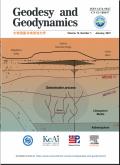Quality assessment of the Topo-Iberia CGPS stations and data quality's effects on postfit ionosphere-free phase residuals
IF 2.8
4区 地球科学
Q2 GEOCHEMISTRY & GEOPHYSICS
引用次数: 0
Abstract
This paper analyzed GPS data from the Topo-Iberia network spanning almost 12 years (2008–2020). The data quality information for all 26 Topo-Iberia stations is provided for the first time, complementing the Spanish Geological Survey's storage work. Data analyses based on quality indicators obtained using TEQC have been carried out. The guidelines and data quality information from the IGS stations have been considered as the quality references, with the stations ALJI, EPCU, and TIOU standing out as the worst stations, while on the contrary, FUEN, PALM, PILA, and TRIA meet the quality requirements to become an IGS station. The relationship between the GPS data quality and their GAMIT- and GipsyX-derived postfit ionosphere-free phase residuals has also been investigated, and the results reveal an inversely proportional relationship. It has been found that the stations showing an increase in elevation of the horizon line, also show an increase in cycle slips and multipath, are among the poorest quality stations, and among those with the highest postfit RMS of phase residuals. Moreover, the evolution of the vegetation around the antenna should be considered as it could cause a progressive loss of quality, which is not complying with the IGS standards. The quality assessment shows that the Topo-Iberia stations are appropriate for geodetic purposes, but permanent monitoring would be necessary to avoid the least possible loss of data and quality. In addition, a method to characterize the GNSS data quality is proposed.Topo-Iberia CGPS台站质量评价及数据质量对拟合后无电离层相位残差的影响
本文分析了Topo-Iberia网络近12年(2008-2020年)的GPS数据。首次提供了所有26个Topo-Iberia站的数据质量信息,补充了西班牙地质调查局的存储工作。根据TEQC获得的质量指标进行了数据分析。我们以IGS台站的指南和数据质量信息作为质量参考,其中ALJI、EPCU和TIOU台站的质量最差,而FUEN、PALM、PILA和TRIA台站的质量符合成为IGS台站的要求。本文还研究了GPS数据质量与其GAMIT-和gipsyx衍生的拟合后无电离层相位残差之间的关系,结果表明两者呈反比关系。研究发现,随着地面线高程的增加,周期跳差和多径的增加,这些站点的质量最差,同时也是相位残差后拟合均方根值最高的站点。此外,应考虑天线周围植被的演变,因为它可能导致质量逐渐下降,这不符合IGS标准。质量评价表明,Topo-Iberia监测站适合大地测量目的,但需要进行长期监测,以尽量减少数据和质量的损失。此外,提出了一种表征GNSS数据质量的方法。
本文章由计算机程序翻译,如有差异,请以英文原文为准。
求助全文
约1分钟内获得全文
求助全文
来源期刊

Geodesy and Geodynamics
GEOCHEMISTRY & GEOPHYSICS-
CiteScore
4.40
自引率
4.20%
发文量
566
审稿时长
69 days
期刊介绍:
Geodesy and Geodynamics launched in October, 2010, and is a bimonthly publication. It is sponsored jointly by Institute of Seismology, China Earthquake Administration, Science Press, and another six agencies. It is an international journal with a Chinese heart. Geodesy and Geodynamics is committed to the publication of quality scientific papers in English in the fields of geodesy and geodynamics from authors around the world. Its aim is to promote a combination between Geodesy and Geodynamics, deepen the application of Geodesy in the field of Geoscience and quicken worldwide fellows'' understanding on scientific research activity in China. It mainly publishes newest research achievements in the field of Geodesy, Geodynamics, Science of Disaster and so on. Aims and Scope: new theories and methods of geodesy; new results of monitoring and studying crustal movement and deformation by using geodetic theories and methods; new ways and achievements in earthquake-prediction investigation by using geodetic theories and methods; new results of crustal movement and deformation studies by using other geologic, hydrological, and geophysical theories and methods; new results of satellite gravity measurements; new development and results of space-to-ground observation technology.
 求助内容:
求助内容: 应助结果提醒方式:
应助结果提醒方式:


